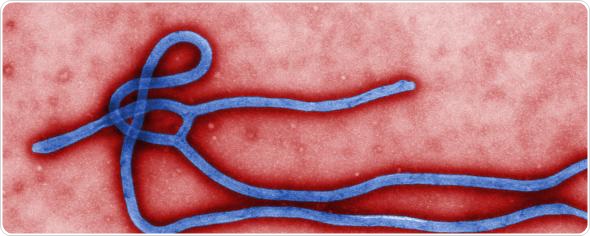Mar 21 2014
The National Institutes of Health (NIH) has awarded a five-year grant of up to $28 million to establish a new center for excellence to find an antibody "cocktail" to fight the deadly Ebola virus. The project, which involves researchers from 15 institutions, will be led by Erica Ollmann Saphire, professor at The Scripps Research Institute (TSRI).
"It's a global collaboration," said Saphire. "Everyone in the field got on the same page to collaborate on a set of definitive experiments."

Microscopic view of Ebola virus
Ebola virus causes an extremely virulent disease that leads to death in 25 to 90 percent of cases. Outbreaks of the fast-moving virus, which spreads via the blood or other bodily fluids of an infected person, have occurred in Uganda and the Democratic Republic of Congo in recent years.
For decades, scientists thought no antibodies were effective against Ebola virus, but in 2012, research from the U.S. Army Medical Research Institute of Infectious Diseases showed that a mix of antibodies can stop the virus. Other labs around the world were simultaneously testing other such antibody cocktails with success.
Today, a whole menu of antibodies have been identified as potentially therapeutic, and researchers are eager to figure out which combinations are most effective and why. Antibodies are currently thought to be the best strategy for treating rare and deadly viruses such as Ebola because they are effective even a couple of days after exposure, a time period during which a person could be airlifted to a hospital for treatment.
With $2.5 million of the grant going to Saphire's laboratory, her team will use a technique called X-ray crystallography to study the structure of the antibodies and how they bind to the virus.
"The structures will provide an essential map for understanding how these antibodies work," Saphire said. "If we understood why some are more effective than others, and which groupings gave better synergy, we could put together a better cocktail."
One unique aspect of this program is that nearly everyone in the field is contributing antibodies. "It will not be this lab's cocktail versus that lab's cocktail," Saphire said, "but an agreement, based upon a blinded study, that what we've put together is the best treatment possible from what is available in the world."
Funding from the grant will also go to TSRI Assistant Professor Andrew Ward for studies using electron microscopy, a different technique for studying molecular structures. TSRI Professor Dennis Burton will contribute antibodies for the study.
Another part of the program is to develop antibody cocktails to fight other hemorrhagic fever viruses such as Marburg, Sudan and Lassa viruses.
Source: NIH National Institute of Allergy and Infectious Diseases